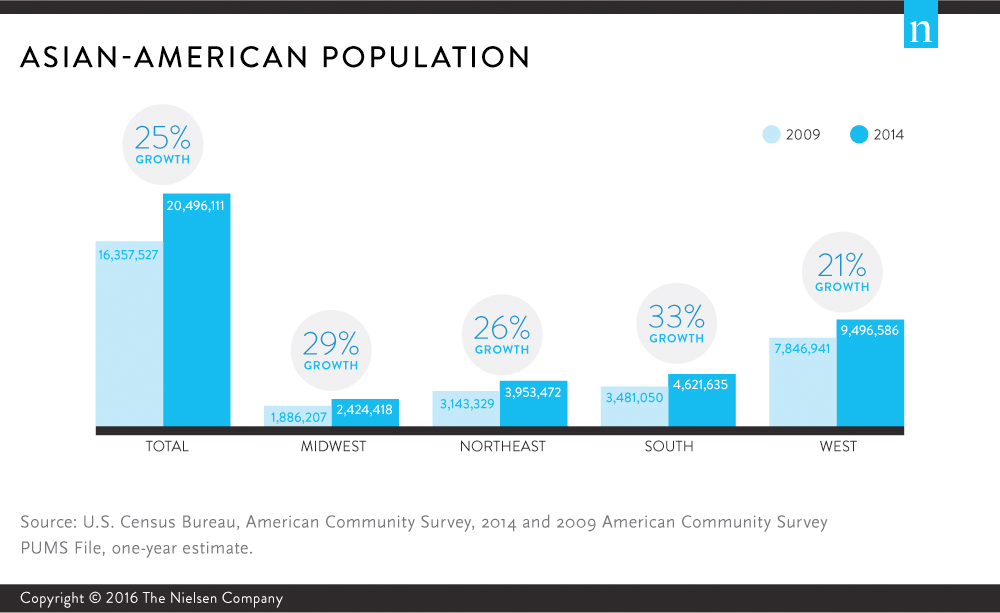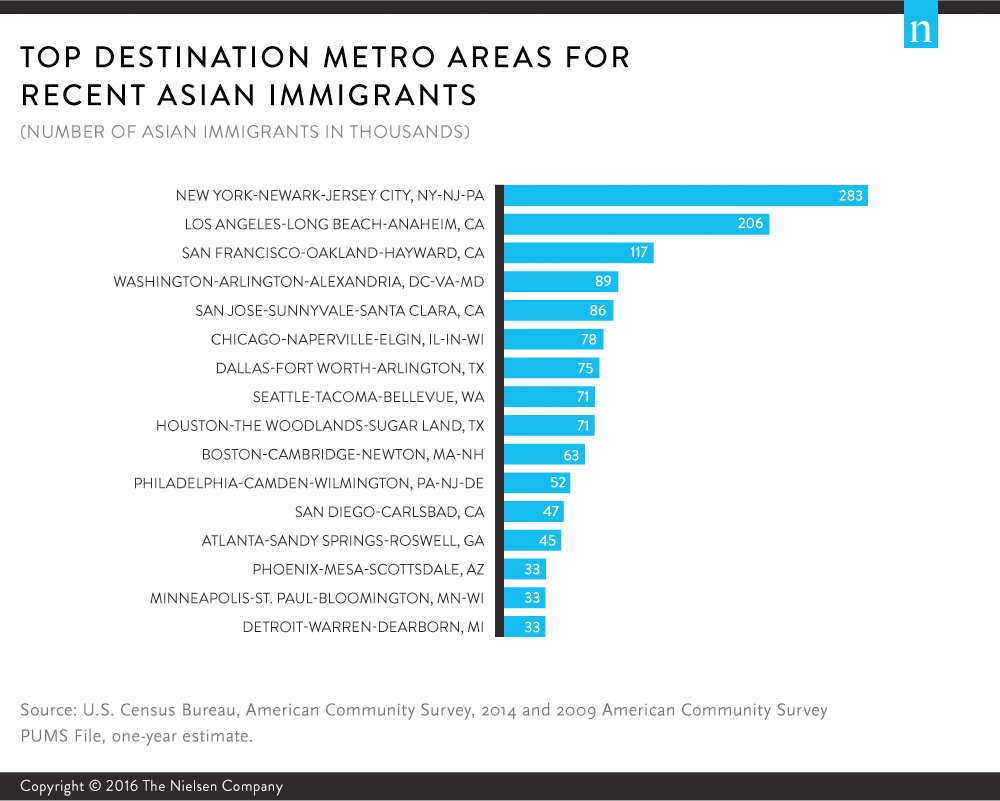Asian-Americans Are Expanding Their Footprint in the U.S. and Making an Impact [REPORT]
May 24, 2016
![]() From food to technology to entertainment, Asian-American influence continues to rise in the U.S. and is spanning across the country.
From food to technology to entertainment, Asian-American influence continues to rise in the U.S. and is spanning across the country.
Still the nation’s fastest-growing population segment, Asian-Americans are about 20.5 million strong and represent 6% of the U.S. population. From 2009-2014, the Asian-American population grew 25%. With immigration from Asian countries continuing to boost the American population, U.S. Census projections show the Asian-American population will reach 25.7 million by 2019. Increasingly diverse, Asian-Americans will outnumber U.S. Hispanics by 2055 according to U.S. Census Bureau projections.
Population is booming in the South and the Midwest
Traditionally, a majority of Asian-Americans have called the Northeast and West regions in the U.S. home. According to findings in Nielsen’s Asian-Americans: Culturally Diverse and Expanding Their Footprint report, however, they’re expanding from those traditional strongholds to the Midwest and South. Though almost half (46%) of Asian-Americans live in the West, which is where 40% (1.65 million) of the Asian-American population growth occurred from 2009 to 2014, the Asian-American population is growing significantly in other U.S. regions as well. Not only is immigration playing a part, but relocations and new births in the South, for example, are helping drive the expansion. In fact, the Asian-American population in the South increased 33% (over 1.1 million) between 2009 and 2014. And the populations in the Midwest and the Northeast grew by 29% (538,000) and 26% (810,000), respectively, during the same time period.

MANY COUNTRIES ARE FUELING THE GROWTH
Asian-Americans are a very diverse group, representing more than 40 countries of origin. Asians of Chinese ancestry are the largest group, comprising 20% of the Asian-American population in the U.S. South-Asian Indians (17%), Filipinos (16%), Vietnamese (9%), Koreans (9%) and Japanese (6%) are the next-largest ethnic groups. Multiracial groups are also among the most rapidly expanding segments of Asian-Americans, making up 18% of the total Asian-American population in 2014.
16 U.S. METROPOLITAIN AREAS COMPRISE MORE THAN HALF OF IMMIGRANT GROWTH
With dense Asian-American populations in the West and Northeast, it’s no surprise that the New York and Los Angeles metropolitan areas are major home bases for this diverse group of consumers. In 2014, 12% (almost 283,000) of recent Asian immigrants settled in the New York metropolitan area, and 8% (206,000) settled in the Los Angeles area. In fact, more than half (63%) of recent Asian immigrants live in 16 U.S. metropolitan areas. Smaller cities, however, including Phoenix, Minneapolis and Detroit, have also seen an influx of Asian-American immigrants.

ASIAN-AMERICANS HAVE SUBSTANTIAL WEALTH AND BUYING POWER
As for buying power, Asian-Americans have the third-largest spending prowess of all multicultural groups, at $825 billion. Put another way, Asian-American buying power in the U.S. is greater than the economies of all but 17 countries worldwide, and slightly greater than the gross domestic product (GDP) of Turkey, according to the Selig Center for Economic Growth, The Multicultural Economy 2015. Their current buying power is expected to increase 32% to $1.1 trillion–or 6.7% of total U.S. buying power—by 2020.
Taking a closer look at median income, with an aggregate view, Asian-Americans are the wealthiest segment of the U.S. population on a per-household basis. With a household median income of $74,829, the median Asian-American household income is 39% greater than the national median income of $53,657. Breaking it down a bit further, there are notable variances in Asian-American median household incomes by region. The median household income for Asian-Americans is highest in the Northeast at $78,592, followed by the West at $75,810, the South at $75,771, and the Midwest at $62,420.
Indian-Americans have the highest household income of any Asian-American group at $101,591. And they represent the first U.S. ethnic segment with a median income of more than $100,000. Filipino-, Japanese-, Chinese- and Pakistani-Americans also have relatively high median incomes: of $82,839; $70,261; $69,586; and $62,848, respectively.

Nielsen’s fourth report on the culturally diverse and dynamic Asian-American consumer looks at a coast-to-coast view of shopping habits, a screen-by-screen view of media habits, and city-by-city view of Asian-American-owned businesses. Young, empowered, and growing, Asian-Americans’ economic clout will continue to expand. Understanding how to connect with this vibrant and multifaceted consumer group in today’s multicultural American mainstream will shape the strategies necessary to succeed now and in the future.
Other report findings include:
- Seventy-nine percent of Asian-Americans agree they prefer cooking with fresh food rather than canned or frozen food. On average, Asian-Americans purchase 69% more fresh seafood, 72% purchase more fresh vegetables, and 29% purchase more fresh fruits than the general population. Asian-American shoppers say they are more likely to buy and pay more for recyclable and eco-friendly products than the general population.
- Asian-Americans outpace the general population in ownership of all three major Internet personal devices: smartphones, household computers and tablets. Online purchasing sentiment outpaces the general market, as well.
- Of the 87 U.S. startup companies valued at over $1 billion with the potential to become publicly traded on the stock market, 19 were founded by Asian-American immigrants.
To download report CLICK HERE.































